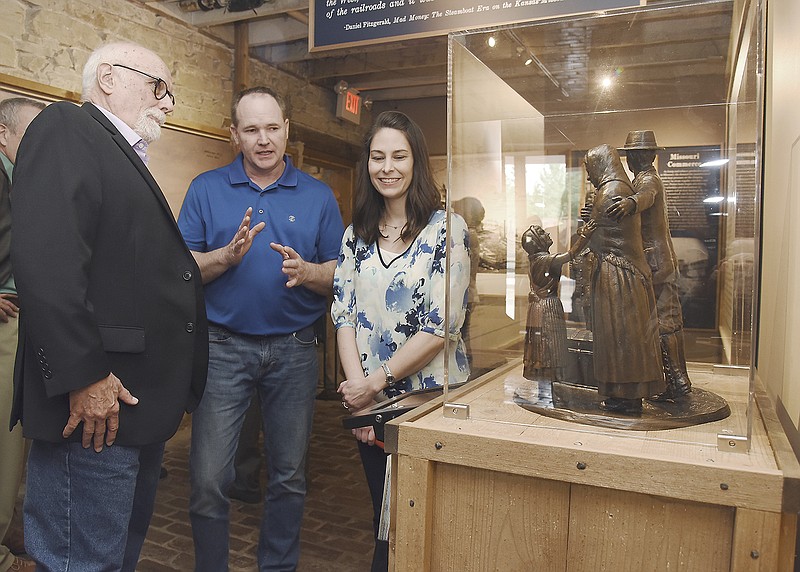Without immigration - especially German immigration - nearly 200 years ago, Missouri would be a very different state today, historian Walter D. Kamphoefner said Monday during ceremonies dedicating a statue to that immigration history.
"It would be a lot smaller in population," Kamphoefner said. "To this day, there are more people of German heritage than any other heritage, including English."
Kamphoefner, a history professor at Texas A&M University, is a St. Charles County native who earned his Ph.D. from the University of Missouri-Columbia.
The statue by sculptor William J. (Bill) Williams - who has a number of works displayed in the Capitol's Hall of Famous Missourians - shows an immigrant family of four, being led by their children, into the challenges of their new lives after getting off a riverboat at Jefferson City.
Jefferson City lawyer Dale Doerhoff, a former president of the Jefferson City Rotary Club who led the effort to get the statue made, noted: "There's a statue at Bremerhaven (Germany) that shows the immigrants who left there, and the father is leading the way.
"(Williams') depiction on this end is that the children are leading the way, and the parents are a little bit hesitant (like) 'What have we gotten ourselves into?'"
Jefferson City-based Firehouse Design created the stand that holds the statue - a stand that replicates the shipping crates immigrants used to bring their possessions from Europe to the New World.
The statue is on display, at least for the next year, in the Lohman Building Museum at the Jefferson Landing State Historic Site, at the foot of Jefferson Street.
By the time of the Civil War, Kamphoefner said, German settlers comprised much of the state's population, and had a great presence in the Union Army and its efforts to keep Missouri a Northern state rather than a Southern one.
"At least a third of the Union Army (in Missouri) and by some accounts, close to half, were Germans," he said.
After the war, Kamphoefner said, one of his great-grandfathers became a state lawmaker "and tried to make the University of Missouri co-educational and racially integrated - in the 1860s."
However, that idea didn't take hold until later, with gender integration coming before the courts ordered racial integration.
Kamphoefner also noted: "Without the Germans, Jefferson City might not have had a Lincoln University because, along with some veterans of the U.S. Colored troops and one black, Jefferson City businessman - (a federal judge) was one of the biggest lights and first promoters of what was first called Lincoln Institute.
"And he continued to serve on its board until 1888, at his death."
Doerhoff introduced Kamphoefner as "a national authority on immigration and ethnicity, with an emphasis on the great Transatlantic migration of the 19th century that brought so many Germans to Missouri," including some of Kamphoefner's own ancestors.
Kamphoefner said many of the German immigrants were tenant farmers in Europe, and didn't own any land in their own right - so they found the idea of leaving Europe for America as a chance to grow.
"The chances of ever becoming a landowner in Germany were extremely slim," he said. "Also, in terms of marriage - marrying across this class divide was pretty unthinkable.
"In fact, I know of several instances of couples who emigrated in order to get married, because it was unthinkable (to do so) back home."
Kamphoefner said, while the opportunity to own land was a big draw for some, "By 1833, what was happening was 'chain migration,' with people going where they already knew people, where they already had family and friends."
He said the German immigrants also "helped to refute the idea that speaking languages other than English somehow indicates disloyalty to the United States."
Doerhoff said the statue was commissioned to help celebrate the centennial (in 2018) of the Rotary Club of Jefferson City's formation.
"We were looking for several projects (including) something that would benefit the state and to recognize the immigrant history of this area," he said. "To dovetail with this wonderful museum seemed like a logical thing to do."
He said Williams is willing to do a life-size version of the statue for the proposed Steamboat Museum - if that ever becomes a reality.
"As we approach (Missouri's) 200th anniversary of statehood, I would like people to remember this state was built by a great wave of immigration that occurred in the 1800s," Doerhoff said, noting many came to America on ships from Europe, then traveled on riverboats up the Mississippi and Missouri Rivers to reach their new homes.
"In the first century of this state, it was populated by a great migration from Europe (that) included Germans, primarily, but there were a lot of Irish and many other nationalities who came here (and) were welcomed - who came to stay and built the state."

